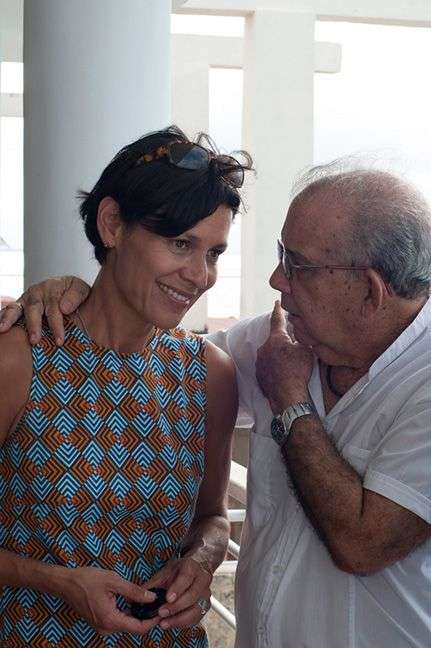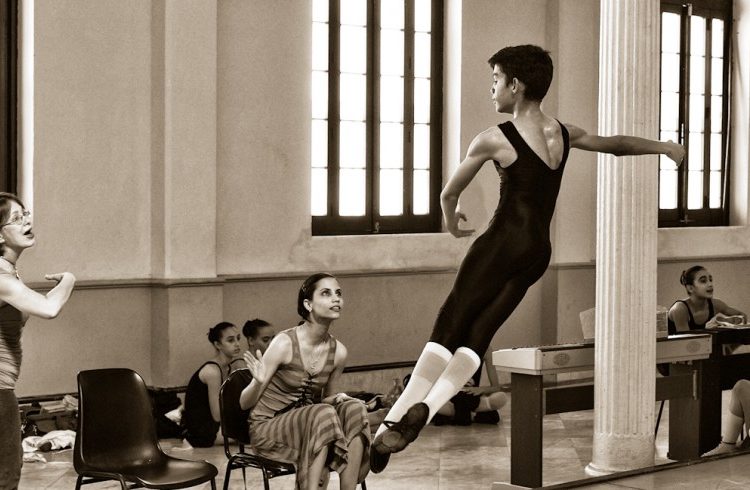¨Portraits of the Cuban School of Ballet¨ is the first exhibition in Cuba by American photographer Rebekah Bowman. Her concern with the lens to capture the dance culture, classical of the Island, now fills the walls of the José Martí Memorial, as part of the activities for the 24th International Ballet Festival of Havana.
Her first camera, her first lessons in photography, thanks to a friend she met while teaching English at the Benito Juarez University of Oaxaca, Mexico. Years later she departed to live in Scotland, where she attended a photography course and sparked further her passion for this art.

But Rebekah is not, at first glance, American or European. Not even Mexican, as suggested by her accent. She has lived throughout the world and has toured with the camera in hand, her other half, and this nomadic appetite seems to have tattooed on her face and in her artist hands a single, generic human culture.
“I am the sum of everything I’ve experienced, what I have seen and what I’ve done in my life. I worked as a waitress, a cook, making cakes, as administrative manager of a chamber orchestra, I have taught at the university … I’ve done a lot of different things, and I think all this is my personality, who I am.
“What I love in the world is to see how we live, what unites us and see us as a big dysfunctional family. What would help us a lot to avoid crashing so much, would be to understand and appreciate each other, recognizing that there are different ways of being and living, there is much we can learn from our diversity and that’s what I’m somehow teach different countries with my job. Art has no boundaries; it is what we have in common. The best of us comes out in art. ”
How do you get to Cuba and to the School of Ballet?
I had little experience with ballet; I loved classical music but did not know much about ballet when I started this project. I had no political objective, I am not a political person, but I had read a lot about this country, I started researching the culture and learned the history of Cuban ballet, which is fascinating. I did not know how difficult it would be to get to the ballet to take pictures, but I have had a lot of luck, starting with Roberto Chile who helped me to approach Alicia for the proposed project to be converted into a book the history of Cuban ballet.
“I think those 22 photographs I chose show at least what I meant with this exhibition: the commitment to work, the cultural heritage of Cuba. I was less interested in the show and more in the teaching, history, and you can see the bond of the teacher passing knowledge, like a torch that is passed from one to another in the classroom, in the halls. ”
Has it been well received by the public?
The exhibition was very well received at the Museum of Performance and Design, San Francisco, but until I could not exhibit it here in Cuba I would not promote it much, because this show was, more than anything, for the Cuban people. Exhibit here is a way to thank the school, and everyone who helped me leave open the window to his world, the children, their parents; I hope they all come to see it.
“Also it is a work in progress still, I want to go with her sometime texts of British Arnold Haskell, the first dance critic to recognize the Cuban School of Ballet, and also quotes from Alicia Alonso, Fernando Alonso and Ramona de Saa like other masters of the Cuban School.
“There is an idea to take the exhibition to Spain, and I would also like to take it to Scotland. What I want is to take it to places where people can come and meet other Cuban form of creative expression, which perhaps they were not aware of. Cuba has so much culture for such a small country. ”
Having lived in several countries and soaked up so many cultures, it may be difficult for you to belong to one place. ¿Has Rebekah took root somewhere?
Truth is not. I was born in the United States; I lived in Colombia and Mexico, when I was little with my family. At 18 I went to live in Germany, then to Salzburg, London, Scotland … The truth is that I’m not rooted anywhere.
“In Scotland everyone knows that I was not from there; in England they thought that maybe I could be from there, but maybe not. No one can put me in a box, and I like that. ”
However there are times when you inevitably have to go back somewhere, or someone, either the pain, loss, frustration … Where do you return to?
… It’s difficult, but certainly to my family, my children, friendship, art. Especially the friendships that I have all over the world, in the places I’ve lived. I am a citizen of the world rather than one country. And maybe that helps a lot to not have a single viewpoint. Traveling always opens the eyes to everybody.











